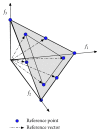An Opposition-Based Evolutionary Algorithm for Many-Objective Optimization with Adaptive Clustering Mechanism
- PMID: 31191632
- PMCID: PMC6525897
- DOI: 10.1155/2019/5126239
An Opposition-Based Evolutionary Algorithm for Many-Objective Optimization with Adaptive Clustering Mechanism
Abstract
Balancing convergence and diversity has become a key point especially in many-objective optimization where the large numbers of objectives pose many challenges to the evolutionary algorithms. In this paper, an opposition-based evolutionary algorithm with the adaptive clustering mechanism is proposed for solving the complex optimization problem. In particular, opposition-based learning is integrated in the proposed algorithm to initialize the solution, and the nondominated sorting scheme with a new adaptive clustering mechanism is adopted in the environmental selection phase to ensure both convergence and diversity. The proposed method is compared with other nine evolutionary algorithms on a number of test problems with up to fifteen objectives, which verify the best performance of the proposed algorithm. Also, the algorithm is applied to a variety of multiobjective engineering optimization problems. The experimental results have shown the competitiveness and effectiveness of our proposed algorithm in solving challenging real-world problems.
Figures













Similar articles
-
A new evolutionary algorithm for solving many-objective optimization problems.IEEE Trans Syst Man Cybern B Cybern. 2008 Oct;38(5):1402-12. doi: 10.1109/TSMCB.2008.926329. IEEE Trans Syst Man Cybern B Cybern. 2008. PMID: 18784020
-
Multiobjective optimization and hybrid evolutionary algorithm to solve constrained optimization problems.IEEE Trans Syst Man Cybern B Cybern. 2007 Jun;37(3):560-75. doi: 10.1109/tsmcb.2006.886164. IEEE Trans Syst Man Cybern B Cybern. 2007. PMID: 17550112
-
Difficulty Adjustable and Scalable Constrained Multiobjective Test Problem Toolkit.Evol Comput. 2020 Fall;28(3):339-378. doi: 10.1162/evco_a_00259. Epub 2019 May 23. Evol Comput. 2020. PMID: 31120774
-
Multiobjective evolutionary algorithms: analyzing the state-of-the-art.Evol Comput. 2000 Summer;8(2):125-47. doi: 10.1162/106365600568158. Evol Comput. 2000. PMID: 10843518 Review.
-
Dragonfly Algorithm and Its Hybrids: A Survey on Performance, Objectives and Applications.Sensors (Basel). 2021 Nov 13;21(22):7542. doi: 10.3390/s21227542. Sensors (Basel). 2021. PMID: 34833621 Free PMC article. Review.
Cited by
-
Feature Selection Based on a Large-Scale Many-Objective Evolutionary Algorithm.Comput Intell Neurosci. 2021 Aug 24;2021:9961727. doi: 10.1155/2021/9961727. eCollection 2021. Comput Intell Neurosci. 2021. PMID: 34484326 Free PMC article.
References
-
- Deb K., Sindhya K., Hakanen J. Decision Sciences: Theory and Practice. Boca Raton, FL, USA: CRC Press; 2016. Multi-objective optimization; pp. 145–184.
-
- Holland J. H. Adaptation in Natural and Artificial Systems: An Introductory Analysis with Applications to Biology, Control, and Artificial Intelligence. Cambridge, MA, USA: MIT Press; 1992.
-
- Beyer H.-G., Schwefel H.-P. Evolution strategies–a comprehensive introduction. Natural computing. 2002;1(1):3–52. doi: 10.1023/a:1015059928466. - DOI
-
- Dorigo M., Birattari M. Encyclopedia of Machine Learning. Berlin, Germany: Springer; 2011. Ant colony optimization; pp. 36–39.
-
- Deb K. Search Methodologies. Berlin, Germany: Springer; 2014. Multi-objective optimization; pp. 403–449.
MeSH terms
LinkOut - more resources
Full Text Sources

